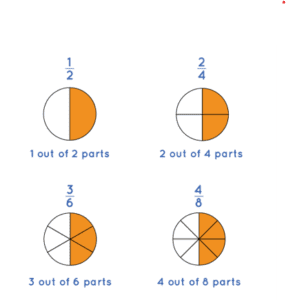Question Equivalent Fractions What are equivalent fractions? Explain how two particles can be equal. Give practical examples of particles that are equivalent. How would you teach this concept to a class?
Equivalent Fractions
Equivalent fractions entail the fractions with different numerators and the denominators representing the same proportion or value of the whole. The equivalent fractions are usually reduced to the same fraction in their simplest form. Equivalent fractions are critical to understanding since they form the basis of fractions’ maths in many aspects (Wessel, 2020).

Explain How Two Fractions Can Be Equivalent.
After they are simplified, two or more fractions are equal to the same value. An explanation of equivalent fractions of 1/5 is 5/25, 4/20, and 6/30. The fractions will reach 1/5 as their simplest forms when they get simplified. Another example that can assist in demonstrating the equivalent fractions is 1/2, 2/4, 3/6, and 4/8 (Wessel, 2020).
How Would You Teach this Concept?
Equivalent fractions are a critical aspect of learning in mathematics. To enhance learners’ understanding of the concepts of equivalent fractions, I would incorporate practical examples to help manage the fear of some learners getting new concepts introduced in class. I would use visuals and images that assist in making learners understand more than the theoretical works (Wessel, 2020).
In the case of equivalent fractions, the topic should incorporate visuals that help the learners see and act practically. Also, the math concept should be described through practice. Therefore, taking fractions and trying to simplify with the learners will facilitate their understanding even more than the theory parts (Wessel, 2020).
In conclusion, the equivalent fractions should be understood from the denominators and numerators and check their values. In the long run, the equivalent fractions are represented as a whole to check if they simplify to the same fraction as the others. Teaching the topic requires the teacher to be understanding the topic better.
References
Wessel, L. (2020). Vocabulary in learning processes towards a conceptual understanding of equivalent fractions—specifying students’ language demands based on linguistic trace analyses. Mathematics Education Research Journal, 32(4), 653-681. https://link.springer.com/article/10.1007/s13394-019-00284-z
